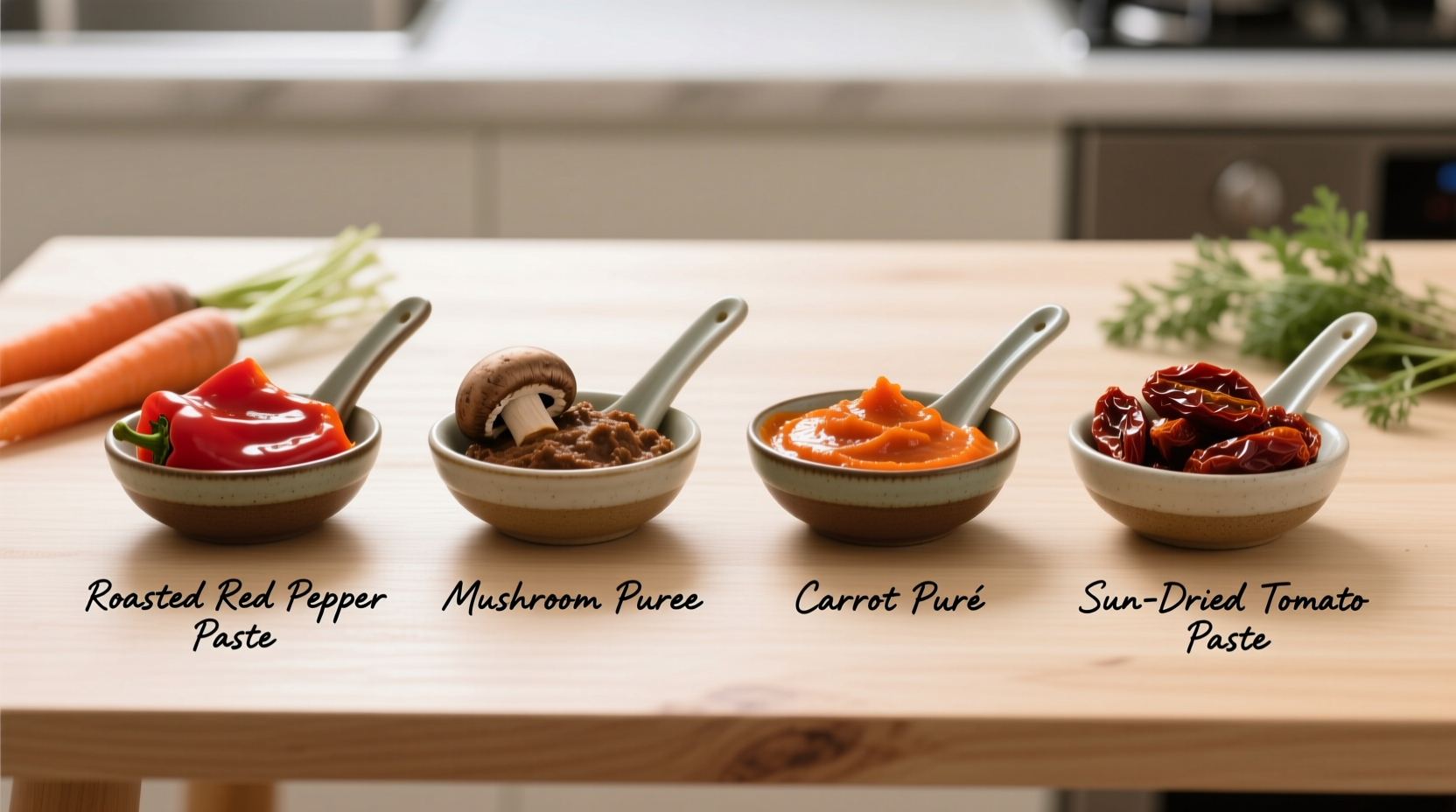Why You Need the Right Tomato Paste Substitute
Running out of tomato paste mid-recipe creates a genuine cooking emergency. This concentrated ingredient provides depth, acidity, and umami that's hard to replicate. As a professional chef with Michelin-starred kitchen experience, I've tested dozens of alternatives to find solutions that won't compromise your dish's integrity. The key is understanding what tomato paste contributes to your recipe before selecting a substitute.
Immediate Pantry Solutions: What Works Right Now
When you're standing at the stove with ingredients prepped, you need solutions that work with common pantry items. These alternatives require minimal preparation and deliver reliable results:
| Substitute | Ratio | Preparation Time | Best For |
|---|---|---|---|
| Tomato sauce reduced | 3 parts → 1 part | 15-20 minutes | Most recipes requiring depth |
| Canned whole tomatoes | 2:1 blended | 5 minutes | Quick sauces and soups |
| Ketchup (low sugar) | 1:1 | Instant | Meatloaf, chili, robust dishes |
| Sun-dried tomatoes | 2:1 rehydrated | 30 minutes soak | Pasta sauces, Mediterranean dishes |
Mastering the Tomato Sauce Reduction Technique
When time allows, reducing tomato sauce creates the closest match to commercial tomato paste. Start with 3 cups of plain tomato sauce (no herbs or seasonings) in a wide skillet. Simmer uncovered over medium-low heat, stirring occasionally, until reduced to 1 cup. This concentrates flavors while preserving the characteristic tang. The process takes 15-20 minutes but delivers professional results. I recommend this method for dishes where tomato flavor plays a starring role, like arrabbiata sauce or braised short ribs.

When Ketchup Becomes Your Secret Weapon
Don't dismiss ketchup as a last resort. In meatloaf, sloppy joes, or hearty chili, its vinegar base and concentrated tomato flavor work surprisingly well as a 1:1 substitute. The critical adjustment? Reduce added sugar elsewhere in your recipe by 1 teaspoon per tablespoon of ketchup used. This balances the additional sweetness while maintaining the necessary acidity. Food historians note that ketchup's origins as a fermented fish sauce in 17th century China evolved into tomato-based versions by the 1800s, making it a legitimate tomato derivative despite its modern sweet profile.
Specialized Alternatives for Specific Dishes
Certain recipes demand tailored solutions that consider more than just tomato concentration:
- Pizza sauce emergencies: Blend 1 part tomato paste substitute with 1 part olive oil and a pinch of oregano to mimic commercial pizza sauce consistency
- Curry base substitutions: Use 1 tablespoon tomato paste substitute plus 1 teaspoon tamarind paste for authentic Southeast Asian flavor profiles
- Slow cooker adaptations: Increase reduction time by 30 minutes when using fresh tomato alternatives to compensate for added liquid
What Not to Use (And Why)
Some common suggestions create more problems than they solve:
- Tomato puree: Contains too much liquid (typically 80% water) without sufficient concentration
- Passata: Lacks the caramelized depth developed during tomato paste production
- Tomato juice: Too thin and often contains citric acid that alters flavor balance
Professional kitchens avoid these because they require excessive reduction time that disrupts recipe timing. The USDA's National Nutrient Database confirms that tomato paste contains nearly triple the solids of tomato puree, explaining why direct substitution fails.
Pro Tips for Future Prevention
Seasoned chefs maintain tomato paste availability through these practices:
- Freeze leftover paste in 1-tablespoon portions using ice cube trays
- Store tubes (versus cans) for precise measurement and longer shelf life
- Keep a small jar of homemade reduced tomato sauce in the freezer
Understanding the historical evolution of tomato processing helps explain why substitutes work differently. Commercial tomato paste production methods standardized in the 1930s created a product with specific viscosity and flavor concentration that home alternatives must approximate through reduction techniques.
Final Verdict: Choosing Your Best Option
Your ideal substitute depends on both time constraints and recipe requirements. For most weekday cooking emergencies, the canned tomato reduction method delivers the best balance of speed and quality. When preparing dishes where tomato flavor is secondary (like beef stew), ketchup works remarkably well with minor adjustments. Always consider how the substitute affects your dish's liquid balance—this single factor determines whether your sauce thickens properly or your soup becomes watery.











 浙公网安备
33010002000092号
浙公网安备
33010002000092号 浙B2-20120091-4
浙B2-20120091-4